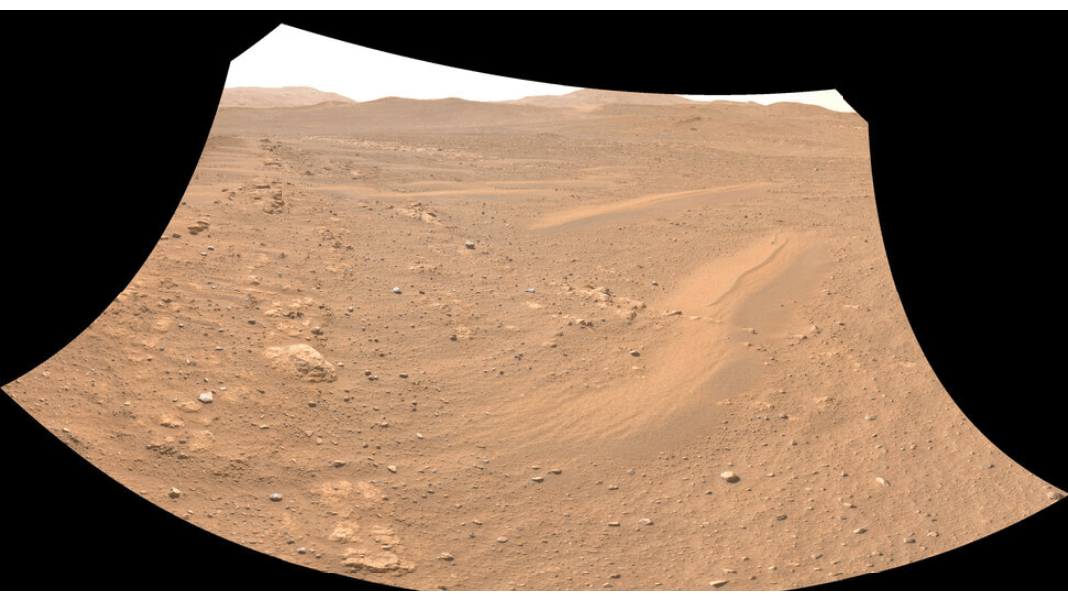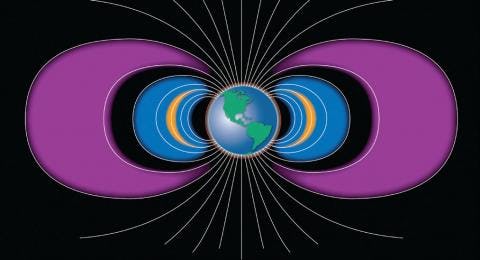
Ninety-nine percent of the universe is an invisible soup of the fourth state of matter, plasma. In a paper published Tuesday in the journal Nature Communications, researchers investigated this subatomic slosh by modeling how its radio chirps might play out on the surface of Mars.
Earth is unusual. It’s got a thin film of neutral gas where we live and breathe. But rise hundreds of miles above the planet’s surface, to roughly the distance between Paris and Amsterdam, and you begin to encounter a problem. It’s the innermost Van Allen radiation belt, discovered during the Space Age in the 1950s, ahead of the Apollo missions. There are two belts, and sometimes, even three.
A key to unlocking the mysteries of plasma, and therefore most of the space environment, are these chirps. This phenomenon, generated thousands of miles above Earth’s surface, remains a puzzle. And it’s important to investigate — the plasma within the Van Allen radiation belts is dangerous to satellites and astronauts. It can also affect our lives on Earth.
“Right now, more than anytime in history, humankind is becoming much much more connected to the space environment,” Jacob Bortnik, paper author, atmospheric scientist and creator of the Space Institute at the University of California Los Angeles, tells Inverse. Our smartphones, he says, run by engaging with a handful of satellites at once, and with time, understanding the space environment will become almost as critical as understanding regular terrestrial weather. These waves are part of that intricacy.
What is plasma?
Plasma is normal gas that has been split into positive and negative charges. The plasma is corralled into the Van Allen radiation belts, shaped like donut-esque bands around Earth, by the same thing that keeps us and everything we love shielded and safe from harmful cosmic radiation: Earth’s electromagnetic field.
This force interacts with plasma, and the whistle tones could be clues about how it moves and alters the realm high above our planet’s surface and elsewhere in the cosmos.
Xin Tao has been thinking about these whistling tones for the last decade. Tao is a paper author and plasma researcher at the Deep Space Exploration Laboratory of the University of Science and Technology of China. And in the new work, he tested his model to explain the chirps. Much like the good old science adage of proving a result can be repeated, he wanted to see if his model, which made sense of the chirps happening at Earth, would also apply on Mars.

“They sound like birds”
These whistling tones or chirps are radio waves. They get their name because “they sound like birds when played on a loudspeaker,” Bortnik says. They come from electromagnetic emissions called chorus waves. “Once we realized they came from space, it was really hard to explain why they chirped the way they chirped,” Bortnik says.
The team decided to use an observation of a chorus emission on Mars. This planet doesn’t have a magnetic field. At least, it’s not global like the one on Earth. Scientists think Mars had one a long time ago, generated by its liquid core. But when that metallic material stopped moving, the magnetic field discontinued.
There are, however, traces of magnetic fields on Mars’ surface. What remains are scattered fields that Bortnik says are “pasted to the crust.” This radically different manifestation is a playground for testing Tao’s theory.
As Tao and Bortnik tell Inverse, Martian fields do a loop, straight up from the surface and back down. This is much different than Earth, which has global apple-half-shaped field lines that feed back into the planet at the poles. It’s why we have auroras at high latitudes, too. Plasma interacts with them both.
What they found
So to better understand plasma and why chorus waves “chirp,” scientists modeled how electromagnetic waves modify the trajectory of the plasma, and the effect on the electromagnetic waves in return.
The model suggests that chirps arise when the plasma comes across “inhomogeneity,” or changes, in the background electromagnetic field. Tao and Bortnik say the model holds up in both planetary scenarios: in Earth’s robust magnetosphere, and the smaller-scale magnetic fields near Mars’ surface.
“The basic idea is that after these waves modify the charged particles, these charged particles at some point need to give energy back to the waves,” Tao tells Inverse.
In essence, the plasma particles make a ring in space, where they gyrate and bounce along the magnetic field. Radio waves are a sign they’re going in the same direction and resonating. But as Bortnik explains, if you instead bunch the plasma particles together like an antenna, and they go into a changing field that alters the rate at which they travel, they radiate in a new way, which creates a new frequency. This culminates as the chirps.
Tao’s model was a success by the team’s assessment. More work will be necessary to show the model is applicable to plasma throughout the Solar System, at the very least.
Beyond explaining our space environment, Bortnik says this science could be the basis for deep space propulsion when probes get too far from the Sun to harness solar energy.
“Space is an exciting place, it has lots of intellectual and practical problems to work on. It touches our daily lives more than we realize,” Bortnik says.







